NavSource Online: Submarine Photo Archive
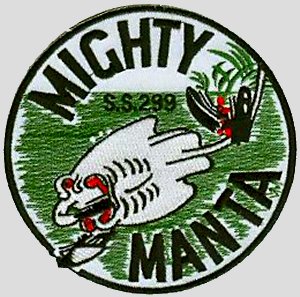
Patch contributed by Mike Smolinski
Please report any broken links or trouble you might come across to the Webmaster.
Please take a moment to let us know so that we can correct any problems and make your visit as enjoyable and as informative as possible.

| Click On Image For Full Size | Size | Image Description | Source | |
|---|---|---|---|---|
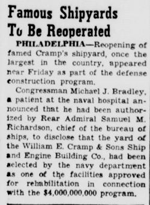 0829914 |
NR | Famous Shipyards To Be Reoperated Reopening of famed Cramp's shipyard, once the largest in the country, appeared near Friday as part of the defense construction program. Congressman Michael J. Bradley, a patient at the naval hospital, announced that he had been authorized by Rear Admiral Samuel M. Richardson, chief of the bureau of ships, disclosed that the yard of the William E. Cramp & Sons Ship and Engine Building Co., had been selected by the navy department as one of the facilities approved for rehabilitation in connection with the $4,000,000,000 program. According to DANFS The second Manta (SS-299) was laid down 15 January 1943 by the Cramp Shipbuilding Co., Philadelphia, Pa. & launched 7 November 1943; sponsored by Mrs. Michael J. Bradley. |
Photo via wikipedia.org Image and text provided by Washington State Library; Olympia, WA. Photo from The Tacoma Times. [volume] (Tacoma, Wash.) 1903-1949, 15 July 1940, Image 7, via chroniclingamerica.loc.gov. |
|
 | 672k | William Cramp & Sons Shipbuilding Company facilities, 15 March 1943. Cruisers visible in this photo: Far right - Miami (CL-89) - Furthest along; aft turrets and catapults in place.Left of Miami is Astoria (CL-90) - she is about a month behind Miami. Left of Astoria, in the large shipway, is Oklahoma City (CL-91) - a significant portion of hull has been built. Left of Oklahoma City is Little Rock (CL-92) - Keel was just been laid on 6 March, which is visible under crane structure. The coaling dock next to the cruisers site is known as grafitti pier" today. Note that there are also 2 ATF's: Seneca (ATF-91) and Nauset (ATF-89) fitting out on the right side near the graving dock being built which was never used when finished in 1945. It was fully functional, and used in the 50's when Keystone Ship Repair leased the property. Fast forward to 2014 when the last piece of the shipyard was demolished. The 'L' shaped building, across Girard Avenue which was the foundry & Machine Shop was the end. Note the 8 submarines in various stages of construction to the left of the Little Rock (4 per shipway). They are most likely from bottom right to left & bottom to top: The shipyard's submarine construction program was not especially successful. Poor management hindered the delivery of the boats. The first delivery was made two years after keel laying, and fitting out was then done by Portsmouth Navy Yard. The best construction time for a submarine was 644 days.
Cramp's submarine construction story was not a happy one for the Navy. Even though they got an early start on their Balaos, they had a lot of difficulty in hiring skilled workers and managers as most of the good ones already had jobs. Quality and timeliness suffered as a result. Cramp used the Government design plans, but used a completely different part numbering and inventory system, making coordination with Portsmouth, Boston, and Mare Island virtually impossible. The Government was forced to step in to straighten the mess out, with some of the boats ultimately being finished by other yards. |
Text courtesy of Tom Bateman, David Johnston (USN, retired) , Ron Reeves (of blessed memory), & Tracy White. USN photo # 80-G-38403 via Tom Bateman courtesy of Tracy White @Researcher @ Large. | |
 | 500k | Inverse of the above. | USN photo # 80-G-38404 via Tom Bateman courtesy of Tracy White @ Researcher @ Large. | |
 |
722k | Captain Clifford H. Roper USN, reads commissioning orders to aboard the Manta (SS-299), Navy Yard Portsmouth N.H., 18 December 1944. | USN photo # 80-G-1222 from NARA, College Park, Maryland, courtesy of Sean Hert. | |
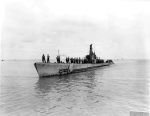 |
109k | Portside view of the Manta (SS-299) approaching the wharf, probably at Pearl Harbor, Hawaii, 10 September, 1945 at the conclusion of her second and last war patrol. | USN photo courtesy of ussubvetsofwwii.org. | |
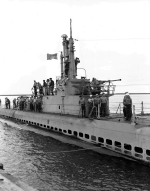 |
161k | Manta's (SS-299) crew lines the deck as her crew secures the lines to the wharf. | USN photo courtesy of ussubvetsofwwii.org. | |
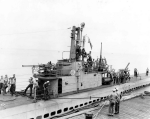 |
158k | Manta's (SS-299) crew lines the deck as her crew secures the lines to the wharf and her crew makes ready to come ashore. | USN photo courtesy of subvetsofwwii.org. | |
 |
32k | Menhaden (SS-377) inboard & Manta (SS-299) on Navy Day at Kahului, Maui Hawaii on 27 October 1945. | Photo courtesy of Lori Mansfield, wife of John Mansfield, Jr., RM2(SS), Menhaden, 1963-65 & Darryl L. Baker. Pamphlet courtesy of Judy Conrad, Ishpeming, Michigan / infomagic.net. | |
 | 137k | Reserve fleet at Mare Island, circa January 1946. There are 52 submarines and 4 Sub Tenders in this photo. This photo is a Berthing list identifying the ships in the picture. | Photo commemorating 50 years, U. S. Submarine Veterans of WW II 1996 calendar, courtesy of Darryl L. Baker. | |
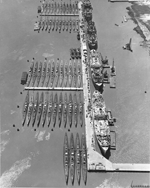 | 453k | Photo of the Reserve fleet at Mare Island, circa January 1946. There are 52 submarines and 4 Sub Tenders in this photo. Whether coincidental or on purpose, the number of boats in the photo is the same as that which were lost in WW II. From back to front and left to right, first group of 12 boats: Sand Lance (SS-381) Tunny (SS-282) Aspro (SS-309) Lionfish (SS-298) Guvania (SS-362) Sunfish (SS-281) Macabi (SS-375) Gurnard (SS-254) Pampanito (SS-383) Mingo (SS-261) Guitarro (SS-363) Bashaw (SS-241) From back to front and left to right, second group of 12 boats: Sealion (SS-315) Hammerhead (SS-364) Bream (SS-243) Seahorse (SS-304) Tinosa (SS-283) Pintado (SS-387) Mapiro (SS-376) Pipefish (SS-388) Moray (SS-300) Batfish (SS-310) Hackleback (SS-295) Bluegill (SS-242) From back to front and left to right, third group of 12 boats: Hawkbill (SS-366) Menhaden (SS-377) Perch (SS-313) Loggerhead (SS-374) Barbero (SS-317) Baya (SS-318) Hardhead (SS-365) Spadefish (SS-411) Springer (SS-414) Devilfish (SS-292) Kraken (SS-370) Dragonet (SS-293) From back to front and left to right, fourth group of 12 boats: Lamprey (SS-372) Piranha (SS-389) Manta (SS-299) Pargo (SS-264) Rancador (SS-301) Archerfish (SS-311) Mero (SS-378) Sawfish (SS-276) Spot (SS-413) Lizardfish (SS-373) Jallao (SS-368) Icefish (SS-367) From back to front and left to right, last group of 4 boats: Steelhead (SS-280) Puffer (SS-268) Stickleback (SS-415) Trepang (SS-412) From back to front, Submarine Tenders group of 4 ships: Pelias (AS-14) Aegir (AS-23) Euryale (AS-22) Griffin (AS-13) | Photo commemorating 50 years, U. S. Submarine Veterans of WW II 1996 calendar, courtesy of Darryl L. Baker. | |
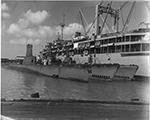 |
545k | Amberjack (SS-522), Sennet (SS-408) & Manta (SS-299) moored to port side of Howard W. Gilmore (AS-16) at Naval Station Key West, Florida, January 1950. | Photo # 80-G-428967 from NARA, College Park, Maryland, courtesy of Sean Hert. | |
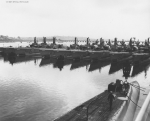 |
173k | Submarines aft of unidentifed submarine in foregroud at Mare Island Reserve Fleet on 28 September 1950 are: Left to right: Dragonet (SS-293), Menhaden (SS-377), Mapiro (SS-376), Seahorse (SS-304), Sand Lance (SS-381), Batfish (SS-310), Capitaine (SS-336), Pipefish (SS-388) and Manta (SS-299). |
USN photo # 6988-9-50, courtesy of Darryl L. Baker. | |
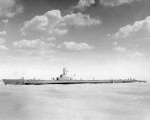 |
46k | Manta (AGSS-299) at Key West, FL. | USN photo. | |
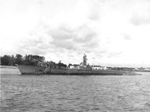 |
509k | I would place the date on this and the following photo somewhere between 1949 and 1955. If you look closely at the stern, you can just see the extra hull plating around the single hull section of the aft torpedo room. This was done during her conversion to a target submarine when she was recommissioned in 1949. The extra plating (which was also placed around the single hull sections of the forward torpedo room) was added to prevent ASW torpedoes with dummy warheads from penetrating her pressure hull if she was struck. The land in the background looks vaguely tropical to me and I always assumed it was Key West, Manta's (AGSS-299) homeport until 1953. If it is indeed New London, then the photo was taken between 1953 and 1955 when she was decommissioned. |
USN photo courtesy of David Buell. Text courtesy of David Johnston. |
|
 |
118k | Manta (AGSS-299) at Key West, FL., 14 December 1953 as she steamed out of Key West for the last time in route to overhaul in Charleston. Previous to this, she had been outfitted as a mobile underwater torpedo target. She had been fitted with additional hull blisters over the single hull ends at the forward and after torpedo rooms to help prevent the dummy torpedoes from penetrating the pressure hull. In addition, both rooms had been filled with balsa wood to minimize the effects of flooding in case the hull was punctured. The forward engine room was emptied to compensate for the additional weight, with the crew turning it into an improvised recreation room. The overhaul in Charleston saw the removal of the wood and the partial restoration of her warfighting abilities, but she retained her AGSS classification. |
USN photo from the Dictionary of American Naval Fighting Ships, courtesy of Joseph M. Radigan (of blessed memory) | |
 |
998k | From left to right: Unnumbered sub, Manta (SS-299) & Flasher (SS-249), Sub Base New London at the north end of the base. Unnumbered submarine is Guardfish (SS-217). She was in the New London Reserve Fleet for a long time before being expended. The masting looks the same as her latewar appearance, but a few features strongly suggest her. The forward gun platform has a turned down spray shield, as Guardfish did. The railings around that platform have stiffeners in an "X" pattern, as did Guardfish. There is also an elliptical vertical "barrel guard" at the front top of that railing to stop the 20mm gun crew from firing downwards and forward, probably to protect anyone on the forward main deck which Guardfish had late/end of war. Although difficult to tell for sure, the venturi appears the same shape, and the railings around the lookout platform atop the shears similarly look "splayed out." The date is between late 1959, (based on early model year car sales for the blue 1960 Chevy Bellaire parked in center foreground) and October 1961, when Guardfish was sunk as a torpedo target in Long Island Sound off New London, Connecticut, by the submarines Dogfish (SS-350) and Blenny (SS-324). |
Photo courtesy of Peter Greis via Fabia Pena. Photo i.d. courtesy of Ric Hednan & Robert Morgan. | |
| Back To The Main Photo Index | Back To the Submarine Index |
|
Problems and site related matters, E-mail Webmaster |
|
This page is created by Gary Priolo, and maintained by Michael Mohl All Pages © 1996 - 2025 NavSource History All rights reserved. |